Featured Application
The results of the research indicate the possible useing of waste sludge water directly in the concrete plant where they are produced. It will reduce waste generation and reduction of payments for their liquidation.
Abstract
This paper presents the results of research dealing with the use of recycled waste sludge water from a concrete plant (CP) as partial or complete replacement of mixing water in cement mixtures. The need to recycle waste sludge water generated as a by-product (waste sludge water) during the production of fresh concrete in the concrete plant results from the environmental and economic problems associated with the operation of the concrete plant. Mixing water was replaced with recycled waste sludge water in the amount of 25%, 50%, 75%, and 100%. In order to determine the effect of partial or complete replacement of mixing water with waste sludge water from the concrete plant in the production of cement composites, laboratory tests of waste sludge water were carried out to determine whether the waste sludge water complies with the requirements for mixing water defined in CSN EN 1008. The tests also determined the properties of fresh cement mortar and hardened cement composites. These were tests of the beginning and end of cement mortar setting, and the strength characteristics (flexural strength, compressive strength). The results of these tests show that it is possible to replace the mixing water by waste sludge water from the concrete plant in the amount of up to 25% without significantly affecting the tested properties, in comparison with the formula containing pure mixing water.
1. Introduction
The reuse of waste sludge water from CP in concrete mixes allows the reduction of waste production and represents a possible new view of this waste as a secondary raw material. In general, if we want to find use for waste material, in our case waste sludge water, we need to investigate its properties with regard to the area of use. As indicated in the studies, researchers most often encounter major problems, such as a higher share of fine particles, the content of substances showing acidic reaction, and a high content of sulphates [1,2]. These waters need to be chemically treated or diluted by adding pure mixing water to comply with the optimum composition of the concrete mixture according to the given formula and also to meet the limits stipulated by the standard [3,4]. However, it has to be taken into account that a higher share of fine particles requires more mixing water to maintain the water–cement ratio for proper hydration, as shown by the studies [5,6,7,8]. Knowing the interactions of the individual components of cement composites, the desired properties of the resulting composites can be achieved. The knowledge of interactions does not only apply to waste mixing water, but can also be applied to other waste products, as suggested by the studies [9,10,11]. In fact, it is estimated that a truck with the volume of 9 m3 carries approximately 300 kg of returned concrete a day. This remaining concrete is generally discharged into large containers and, after hardening, the concrete can be crushed and used as recycled aggregate for further construction. After emptying the rest of fresh concrete, the agitation truck is washed with large amount of water, 700–1300 litres per truck, and the scattered mass settles in large sedimentation tanks [12,13]. Due to the large amount of suspended substances and high alkaline conditions, untreated sludge water cannot be legally discharged into municipal sewer systems [1]. Water is an important component of concrete. It participates in the hydration of cement, but also contributes to the workability of fresh concrete. The quality of mixing water is therefore crucial for the properties of fresh concrete, including the strength and durability. Most standards specify that water used as mixing water must be clean and free from oils, acids, alkalis, organic matter, or other harmful substances [14,15]. Complete recycling of sludge in concrete plants is considered because of its great benefits in terms of the reduction of the costs of disposal, as well as the protection of the environment. The use of washing water from concrete plants for the preparation of fresh concrete was studied by Borger et al., and they focused their attention on an experimental study in order to determine compressive strength, sulphate resistance, workability, and setting times of cement mortar [16]. A study on the use of sludge from concrete plants has found that concrete mixed with sludge water containing residual cement tends to show shorter setting time and lower fluidity [1,17]. In the study “Properties and possible recycling of solid waste from ready-mix concrete”, the use of a fine fraction of the waste slurry (adding solid waste) led to a reduction in the compressive strength [18]. Sandrolini et al. used washing water from a concrete plant mixed with water from a water main for the production of concrete and mortar. Their results have shown that after 28 days, the compressive strength of most samples was higher than 96% of the reference samples of concrete [12,19]. Apart from that, dry sludge can be used as binder or filler for the production of concrete mixture, following a study on the use of sediment from water management tanks [20]. Because this material has natural fineness, it can be used as the product replacing very commonly used limestone-cement fillers. This helps to preserve natural resources, save energy (crushing and grinding is a very energy-intensive process), and recycle waste [21].
2. Materials and Methods
The preparation and determination of the strength of cement composites was performed according to the standard CSN EN 196-1 [22]. The cement composites were prepared using waste sludge water resulting from the recycling of waste sludge water from the concrete plant, meeting the parameters of CSN EN 1008 [23].
2.1. Components of the Designed Formulas
2.1.1. Sand
Standard sand according to the requirements of CSN EN 196-1 [20] was used in three fractions marked PG I (0.08–0.5 mm), PG II (0.5–1 mm), and PG III (1–2 mm). These fractions are represented in a volume ratio of PG1:PG2:PG3—33.3:33.3:33.3%. The total agent filler weight was 1350 g.
2.1.2. Cement
Two types of cement were used for the designed formulas: Portland cement CEM 52.5 R containing 95% of Portland clinker and 5% of additional components (fly ash). Mixed Portland cement CEM II/B-LL 32.5 R was used as well. It contains 65% of Portland clinker, 30% of limestone (LL) and 5% of additional components (fly ash).
2.1.3. Mixing Water
Mixing water has two basic functions. The first function is hydration (cement hydration creates rigid cement stone structures), the other one is rheological (allows you to create fresh mixture together with its components). The mixing water was tested to the requirements given in the standard of CSN EN 1008 [23]. The resulting properties of pure mixing water and waste sludge water from the CP are shown in Table 1. It is apparent that the standard limits given in CSN EN 1008 [23] were not exceeded for the pure mixing water sample or for the waste sludge water sample from the concrete plant, and they comply with the mixing water requirements. Furthermore, it is apparent that the monitored concentrations of analytes in the waste sludge water from the concrete plant in comparison with pure mixing water were approximately 20 times higher, for example, in case of sulphates and nearly 13 times higher in case of chlorides.

Table 1.
Results of analyses of pure mixing water and recycled waste sludge water from the concrete plant (CP).
Table 1 shows the comparison of the measured values of the monitored parameters according to the standard CSN EN 1008 [23] in the samples of pure and waste sludge water from the CP plant. The sulphate content in waste sludge water in Stage 1 is higher by 20.8 times and in Stage 2 is higher by 12 times then in pure mixing water. The chloride content in waste sludge water in Stage 1 is higher by 15.2 times and in Stage 2 is higher by 4.3 times then in pure mixing water. The nitrate content in waste sludge water in Stage 1 is higher by 3.8 times and in Stage 2 is higher by 2.6 times then in pure mixing water. An explanation of these facts is that anhydrite concretes were prepared in the concrete plant before to the sampling. This explanation which confirms the significant increase of sulphates in the tested waste sludge water samples. The sequence of production stages of fresh concrete mixture in concrete plants is different during the day, week, month and year, the properties of these waste sludge waters change as well, and they can influence the properties of fresh mixtures for the production of cement composites. The properties of samples waste sludge water are related to the type of concrete prepared in the concrete plant.
2.2. Formula Design
Two recipes with the designation of R1 and R3 have been proposed to verify the use of waste sludge water as a mixing water. The composition of the designed formulas is shown in Table 2. The designed formulas of cement composites were in compliance with the standard requirements according to CSN EN 196-1 [22]. The individual components of Formulas R1 and R3 are presented in the table below. Pure mixing water was replaced with 25% (1/4), 50% (1/2), 75% (3/4) and 100% (1) of waste sludge water from the concrete plant.

Table 2.
Composition of designed formulas.
2.3. Mineralogical Analysis of Solids Obtained from Waste Sludge Water
The mineralogical analysis of the solids from waste sludge water samples from the CP was performed using a Bruker Advance D8 powder diffractometer equipped with a LynxEye linear semiconductor detector and a SOL-XE energy dispersive detector. The samples were obtained by filtering the sludge water and subsequent drying of the solids at 105 °C in a Memmert dryer to a steady weight. The samples were also subjected to a grinding process in a concrete test vibration mill for 1 min and were screened through a 0.063 mm mesh screen. A substantial part of the samples was subjected to mineralogical analysis.
2.4. Consistency
The consistency of the cement mortar was determined according to CSN EN 1015-3 [24]. The test is based on measuring the diffusion of fresh cement mixture on a flow table after 15 compaction strokes.
2.5. Initial and Final Setting Time
The test was performed according to CSN EN 196-3 “Methods of testing cement—Part 3: Determination of setting times and soundness” [25].
2.6. Strength Characteristics
The test of tensile flexural strength and compressive strength at the end of the beams was performed according to CSN EN 196-1 [22].
3. Results and Discussion
3.1. Mineralogical Sludge Composition
Figure 1 and Figure 2 present the results of a mineralogical analysis of two samples of solids from recycled sludge water from the concret plant labeled Stage 1 and 2. Figure 1 clearly shows that significant mineralogical proportions consist of these minerals: silica (SiO2) 10%, bassanite (CaSO4·0.5H2O) 26%, and limestone (CaCO3) 42%. In the sludge water sample marked Stage 2 (see Figure 2), significant mineralogical composition consists of these minerals: thaumasite (Ca3Si(OH)6(CO3)(SO4)·12H2O) 33%, calcium sulphate (CaSO4·2H2O) 23%, calcite (CaCO3) 9%, bassanite (CaSO4·0.5H2O) 17%, and silica (SiO2) 5%. The presented results of the mineralogical analysis of the solids of two types of waste sludge water samples from the concrete plant showed different mineralogical composition which, as mentioned above, depends on the type of concrete mixture that is currently produced in the concrete plant and subsequently washed out and recycled by rinsing. Due to the different mineralogical composition of the solids contained in the waste sludge water from the CP, it is necessary to determine the optimal possible replacement of pure mixing water with the waste sludge water from the CP experimentally, in order not to affect the physical–mechanical properties of the produced concrete.
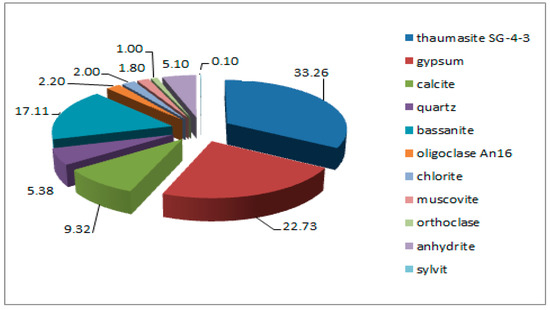
Figure 1.
Mineralogical analysis of solids sample (Stage 1) acquired from waste sludge water [%].
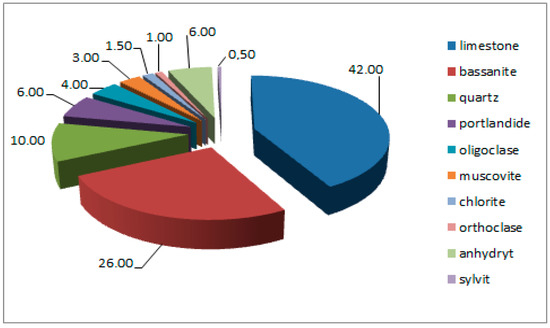
Figure 2.
Mineralogical analysis of solids sample (Stage 2) acquired from waste sludge water [%].
3.2. Consistency of Fresh Mixture
Table 3 presents the results of consistency tests of Formulas R1 and R3. In Formula R1 using cement CEM 52.5 R, it is clear that 25% replacement of pure mixing water with waste sludge water from the concrete plant reduces the diffusion value by 7.5%, 50% replacement reduces the diffusion value by 16.9%, 75% the replacement reduces the diffusion value by 23.1% and 100% replacement reduces the diffusion value by 31.3%. When using cement CEM II/B-LL 32.5 R (Formula R3), it is clear that 25% replacement of pure mixing water with waste sludge water from the CP decreases the diffusion value by 7.3%, 50% replacement reduces the diffusion value by 14%, 75% replacement reduces the diffusion value by 22%, and 100% replacement reduces the diffusion value by 26.8%.

Table 3.
Consistency of fresh mixture.
Figure 3 presents the results of a linear regression of diffusion values taking into account the percentage replacement of pure mixing water with waste sludge water from the CP of Formulas R1 and R3. The coefficient of determination R2 is 0.9973 for Formula R1 and 0.9956 for Formula R2. Based on these values of the coefficient of determination (values approaching the value of 1), it can be stated that the equations presented in the graphs (see Figure 3) can be used for extrapolation of diffusion value in the interval of 0–100% replacement of mixing water with waste sludge water from the CP. Figure 3 also clearly shows that the increasing replacement of pure mixing water with waste sludge water from the CP reduces the diffusion value. The reduction is due to an increasing proportion of fine particles that are present in the sludge water from the CP. The increasing content of fine particles is directly dependent on the increasing replacement of pure mixing water with waste sludge water from the CP. This is in line with the results of an experimental research dealing with the use of fine proportions of recycled aggregate in the production of concrete [16]. It has been established that the increasing proportion of fine particles in concrete mixture reduces the consistency of fresh concrete mixture.

Figure 3.
Linear dependence of the diffusion value of Formulas R1 and R3 on the replacement of mixing water with waste sludge water from the concrete plant.
3.3. Initial and Final Setting Time of Cement Paste
A Vicat BC VIC-08 automatic instrument was used to determine the initial setting time and final setting time. The results of the test are presented by the values of the initial and final setting time of cement paste in Formulas R1 and R3. The results are presented in Table 4.

Table 4.
Values of the initial and final setting time of Formulas R1 and R3.
The table presented above shows the results of the initial setting time and final setting time of the tests of Formulas R1 and R3. For Formula R1 with CEM I 52.5R, it has been demonstrated that a 25% replacement of pure mixing water with waste sludge water from the CP shortens the initial setting time by 23 min (11%) and shortens the final setting time by 16 min (6.7%). A 50% replacement shortens the initial setting time by 75 min (35.7%) and accelerates the final setting time by 78 min (32.5%). A 75% replacement shortens the initial setting time by 85 min (40.5%) and accelerates the final setting time by 78 min (32.5%). 100% replacement shortens the initial setting time by 100 min (47.6%) and accelerates the final setting time by 94 min (39.2%). For the R3 formula with CEM II/B-LL 32.5R, it has been demonstrated that a 25% replacement of pure mixing water with waste sludge water from the CP shortens the initial of the setting time by 30 min (15%) and shortens the final setting time by 41 min (16.7%). A 50% replacement shortens the initial of the setting time by 55 min (27.5%) and accelerates the final setting time by 66 min (26.8%). A 75% replacement shortens the initial setting time by 68 min (34%) and accelerates the final setting time by 71 min (28.9%). 100% replacement shortens the initial setting time by 80 min (40.0%) and accelerates the final setting time by 79 min (32.1%). The facts stated above show that if the mixing water is replaced with more than 25% of waste sludge water from the CP, it is possible to extend the initial setting time of the cement paste by adding a suitable plasticizer or superplasticizer. However, a suitable type of plasticizing or superplasticizing additive must be verified by an experiment.
Exponential functions are interleaved through the final values in the graphical expression of the initial and final setting time (see Figure 4). The suitability of using exponential function is based on the high value of the coefficient of determination that is close to 1. In case of Formula R1, the coefficient of determination R2 for the initial setting time is 0.95 and for the final setting time 0.89. In case of Formula R3, the determination coefficient R2 for the initial setting time is 0.98 and for the final setting time 0.89. These values show a very close dependence of the initial and final setting time on the replacement of pure mixing water with waste sludge water from the CP.
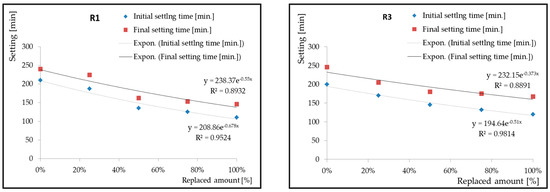
Figure 4.
Exponential dependence of the initial and final setting time of Formulas R1 and R3.
3.4. Strength Characteristics
Samples with the dimensions of 40 × 40 × 160 mm were used for the testing of flexural and compressive strengths of the experimental Formulas R1 and R3. The determination of the strength parameters was performed after 28 and 90 days of age of the test specimens, always on one set of the test specimens. Figure 5 and Figure 6 show the results of average flexural strengths of the experimental formulas.
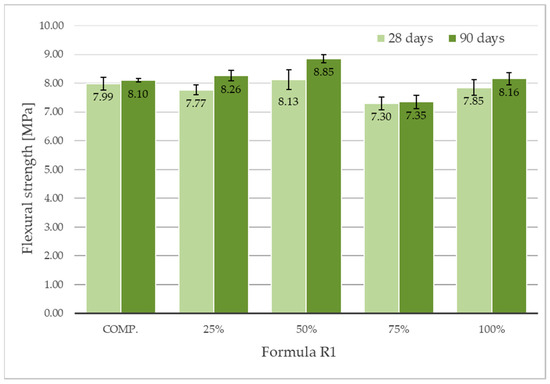
Figure 5.
Flexural strength of Formula R1 with 25%, 50%, 75%, and 100% of mixing water replaced with waste sludge water from the CP.
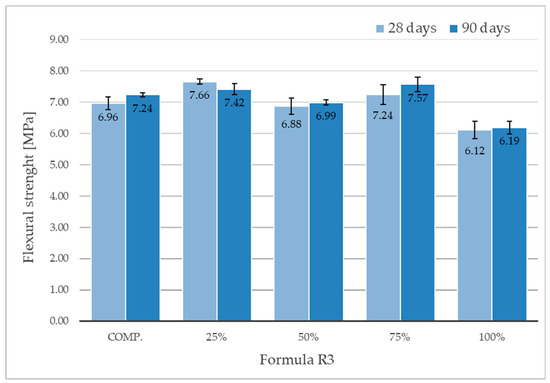
Figure 6.
Flexural strength of Formula R3 with 25%, 50%, 75% and 100% of mixing water replaced with waste sludge water from the CP.
The results of flexural strength test of Formula R1 with CEM I 52.5R, which are presented in Figure 5, show that the flexural strengths after 28 days are within the range of 7.30 to 8.13 MPa, with the highest value of 8.13 MPa being found for 50% replacement and the lowest value of 7.30 MPa for 75% replacement of pure mixing water with waste sludge water from the CP. The flexural strength after 90 days ranged from 7.35 to 8.85 MPa. The highest value of 8.95 MPa was achieved for 50% replacement and the lowest for 75% replacement. It is also apparent that after 90 days, there was an increase in flexural strength compared to the comparative value (i.e., 8.10 MPa) for 25%, 50%, and 100% replacement of pure mixing water with waste sludge water from the CP. This phenomenon is not evident for the flexural strengths determined after 28 days of the test samples.
The results of the flexural strength tests after 28 and 90 days of the age of the test specimens prepared according to Formula R3 with CEM II/B-LL 32.5R (see Figure 6) show that the strengths after 28 days were within the range of 6.12–7.66 MPa and after 90 days within the interval of 6.19 to 7.57 MPa. In comparison with the flexural strength test of R1 formula, the strengths values are lower as a result of the use of different kind of cement with lower strength class. The highest flexural strength after 28 days (7.66 MPa) was found in case of 25% replacement and the lowest value (6.12 MPa) in case of 100% replacement. Further, Figure 6 shows the flexural strengths after 90 days showed the highest value (7.57 MPa) in case of 75% replacement and the lowest value (6.19 MPa) in case of 100% replacement.
The Figure 7 clearly shows that the replacement of pure mixing water in the amounts of 25%, 50%, 75%, and 100% with waste sludge water from the CP caused a decrease in the compressive strength after 28 days. The highest decrease in strength was found in case of 50% replacement of pure mixing water, i.e., by 8.57 MPa (12.5%). This trend of the decrease of compressive strength after 28 days is no longer apparent after 90 days. On the contrary, there was an increase in the strength compared to the comparative formula (replacement of 0%). The highest increase of 12.34 MPa (1.18 times) was recorded in case of 75% replacement of pure mixing water with waste sludge water from the CP. It can be concluded that when 25%, 50%, 75%, and 100% of pure mixing water is replaced with waste sludge water from the CP, it is necessary to take into account a decrease of the compressive strength after 28 days in the interval of 5.2% to 12.5%, depending on the percentage replacement. On the contrary, in the time interval of 28 to 90 days, there is an increase in compressive strength compared to the comparative formula (replacement of 0%) in the inerval of 9.2% to 18.0%, depending on the extent of percentual replacement.
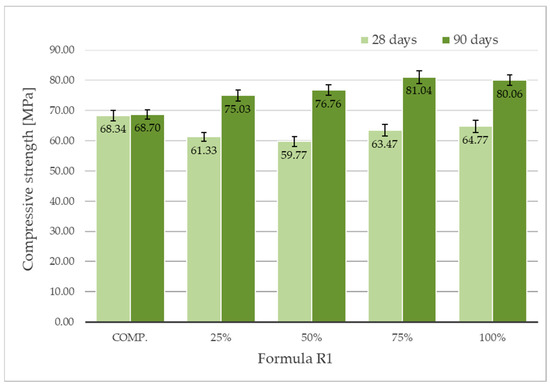
Figure 7.
Compressive strength of formula R1 with 25%, 50%, 75%, and 100% of mixing water replaced with waste sludge water from the CP.
The following conclusions can be drawn on the basis of the results of the compressive strength tests of R3 formula, which are presented in Figure 8. After 28 days of the test samples, a 25% replacement of pure mixing water with waste sludge water from the CP caused an increase in strength of 2.66 MPa (4.8%). The same trend of an increase in the strength was found in case of 75% replacement, when the compressive strength increased by 6.63 MPa (12%). The trend showing a decrease of the strength was found in case of 50% and 100% replacement. In formula R1, when CEM I 52.5R was used as the binder, as well as in formula R3 with CEM II/B-LL 32.5R used as the binder, there is an increase in compressive strength in time interval of 28–90 days as well. The growth interval ranges from 2.9 to 13.3%, depending on the extent of the percentage replacement.
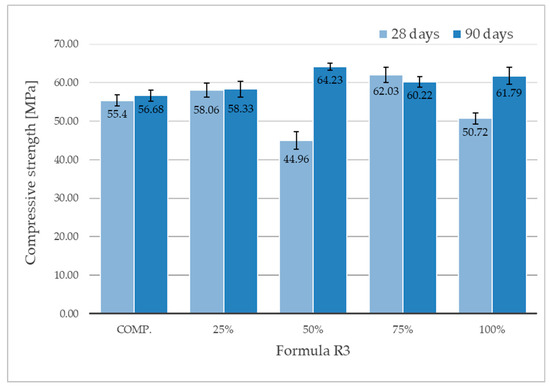
Figure 8.
Compressive strength of formula R3 with 25%, 50%, 75% and 100% of mixing water replaced with waste sludge water from the CP.
4. Conclusions
This paper presents the results of an experimental research of the possibility of an effective use of recycled waste sludge water from CPs. Waste sludge water is mostly a product of agitation truck rinsing. The aim of the research was to understand the properties of the waste sludge water from the CP plant in order to assess the possibility of its use as mixing water in the production of cement composites. Based on the presented results of the experimental research, we can draw the following conclusions:
- -
- The replacement of pure mixing water with waste sludge water from the CP in the amounts of 25%, 50%, 75%, and 100% is possible, because the properties of the waste sludge water from the CP meet the limit requirements for mixing water stipulated in CSN EN 1008 (see Table 1).
- -
- The replacement of mixing water with 25%, 50%, 75%, and 100% of waste sludge water from the CP affects the consistency of the fresh concrete mixture when using CEM I 52.5R and CEM II/B-LL 32.5R as the binder. The higher the replacement, the lower the diffusion value and there is also a negative impact on the workability of the fresh cement mixture.
- -
- Replacing the mixing waste sludge water with 25%, 50%, 75%, and 100% of water from the concrete plant will accelerate the initial setting time and shorten the final setting time of the mixture when using CEM I 52.5R and CEM II/B-LL 32.5R as the binder. Another factor affecting mortar workability may be the increased chloride content in waste sludge water from the concrete plant, which may accelerate the initial setting time as indicated in [21]. This phenomenon can be suppressed by the addition of a suitable plasticizer or superplasticizer.
- -
- Replacement of mixing water with, in the amounts of 25%, 50%, 75%, and 100%, waste sludge water from the concrete plant when using Portland cement CEM I 52.5R (Formula R1):
- Does not significantly reduce flexural strength after 28 and 90 days of age.
- Causes a decrease in compressive strength after 28 days (maximum by 12.5%), but after 90 days, there is an increase in strength (maximum by 18%) compared to a comparative formula without waste sludge water from the CP.
- In terms of the results of the strength characteristics, 75% replacement of pure mixing water with waste sludge water from the CP shows the best results.
- -
- Replacement of mixing water with waste sludge water from the CP in the amounts of 25%, 50%, 75%, and 100% while using Portland CEM II/B-LL 32.5R mixed cement (Formula R3):
- Increases the flexural strength after 28 days for 25% and 75% replacement of pure mixing water with waste sludge water from the CP, and the same trend is seen in case of flexural strength after 90 days.
- Increases the compressive strength after 28 days for 25% and 75% replacement of pure mixing water with waste sludge water from the CP. After 90 days, the compressive strength of all mixing water replacements with waste sludge water from the CP will be increased.
- The research results show that despite the acceleration of the hydration process at the initial setting time, this process continues after 90 days and increases the strength of the tested samples.
- In terms of the results of the strength characteristics, 75% replacement of pure mixing water with waste sludge water from the CP shows the best results.
Author Contributions
V.V. and T.D. conceived and designed the experiments; L.K. performed the experiments. T.D., L.K. and J.S. analyzed the data; T.D., J.S., J.B. contributed reagents/materials/analysis tools. L.K., T.D., J.S. and V.V. wrote the paper.
Funding
This research was funded by VŠB–TUO, Faculty of Mining and Geology—grants numbers SP2018/12, SP2019/29; Moravian-Silesian Region—grant number RRC/10/2018; The Ministry of Education, Youth and Sports—National Sustainability Program I—grant number LO1406.
Conflicts of Interest
The authors declare no conflict of interest.
References
- Chatveera, B.; Lertwattanaruk, P. Use ofready-mixed concrete plant sludge water in concrete containing an add it iveorad mixture. J. Environ. Manag. 2009, 90, 1901–1908. [Google Scholar] [CrossRef] [PubMed]
- Chatvera, B.; Lertwattanaruk, P.; Makul, N. Effect of sludge water from ready-mixed concrete plant on properties and durability of concrete. Cem. Concr. Compos. 2006, 28, 441–450. [Google Scholar] [CrossRef]
- Tsimas, S.; Zervaki, M. Reuse of waste water from ready-mixed concrete plants. Manag. Environ. Qual. 2011, 22, 7–17. [Google Scholar] [CrossRef]
- Ghair, A.M.; Othman, A.A.; Mohmd, K.S.; Nedal, A.; Farroura, M.; Sharon, B.M. Influence of greywater on physical and mechanical properties of mortar and concrete mixes. Ain Shams Eng. J. 2016, 9, 1519–1525. [Google Scholar] [CrossRef]
- Tkach, E.V.; Semenov, V.S.; Tkach, S.A.; Rozovskaya, T.A. Highly Effective Water-repellent Concrete with Improved Physical and Technical Properties. Procedia Eng. 2015, 111, 763–769. [Google Scholar] [CrossRef]
- Xu, B.; Winnefeld, F.; Kaufmann, J.; Lothenbach, B. Influence of magnesium-to-phosphate ratio and water-to-cement ratio on hydration and properties of magnesium potassium phosphate cements. Cem. Concr. Res. 2019, 123, 81. [Google Scholar] [CrossRef]
- Domagała, L. The Effect of Lightweight Aggregate Water Absorption on the Reduction of Water-cement Ratio in Fresh Concrete. Procedia Eng. 2015, 108, 206–213. [Google Scholar] [CrossRef]
- Aïtcin, P.C. 17—The Influence of the Water/Cement Ratio on the Sustainability of Concrete. Chem. Cem. Concr. 2019, 5, 807–826. [Google Scholar]
- Estokova, A.; Smolakova, M.; Luptakova, A.; Strigac, J. Changes in water absorptivity of slag based cement mortars exposed to sulphur-oxidising A. Thiooxidans bacteria. IOP Mater. Sci. Eng. 2017, 251, 012034. [Google Scholar]
- Ondova, M.; Stevulova, N.; Palascakova, L.; Estokova, A. The study of concrete properties prepared with a proportion of fly ash. Poll. Per. 2014, 9, 105–115. [Google Scholar] [CrossRef]
- Ondova, M.; Stevulova, N.; Estokova, A. The study of the properties of fly ash based concrete composites with various chemical ad mixtures. Pollack Period. 2012, 1, 1863–1872. [Google Scholar]
- Sandrolini, F.; Franzoni, E. Waste wash water recycling in ready-mixed concrete plants. Cem. Concr. Res. 2001, 31, 485–489. [Google Scholar] [CrossRef]
- Audo, M.; Mahieux, P.-Y.; Turcry, P. Utilization of sludge from ready-mixed concrete plants as a substitute for limestone fillers. Constr. Build. Mater. 2016, 112, 790–799. [Google Scholar] [CrossRef]
- Su, N.; Miao, B.; Liu, F.-S. Effect of wash water and underground water on properties of concrete. Cem. Concr. Res. 2002, 32, 777–782. [Google Scholar] [CrossRef]
- Babu, G.; Madhusudana, B.; Venkata Ramana, N. Quality of mixing water in cement concrete “a review”. Mater. Today Proc. 2018, 5, 1313–1320. [Google Scholar] [CrossRef]
- Borger, J.; Carrasquillo, R.L.; Fowler, D.W. Use of recycled wash water and returned plastic concrete in the production of fresh concrete. Adv. Cem. Based Mater. 1994, 1, 267–274. [Google Scholar] [CrossRef]
- Paolini, M.; Khurana, R. Admixtures for recycling of waste concrete. Cem. Concr. Compos. 1998, 20, 221–229. [Google Scholar] [CrossRef]
- Pistilli, M.F.; Peterson, C.F.; Shah, S.P. Properties and possible recycling of solid waste from ready-mix concrete. Cem. Concr. Res. 1975, 5, 249–259. [Google Scholar] [CrossRef]
- Asadollahfardi, G.; Asadi, M.; Jafari, H.; Moradi, A.; Asadollahfardi, R. Experimental and statistical studies of using wash water from ready-mix concrete trucks and a batching plant in the production of fresh concrete. Constr. Build. Mater. 2015, 98, 305–314. [Google Scholar] [CrossRef]
- Junakova, N.; Junak, J. Sustainable use of reservoir sediment through partial application in building material. Sustainability 2017, 9, 852. [Google Scholar] [CrossRef]
- Zervaki, M.; Leptokaridis, C.; Tsimas, S. Reuse of By-Products from Ready-Mixed Concrete Plants for the Production of Cement Mortars. J. Sustain. Dev. Energy Water Environ. Syst. 2013, 1, 152–162. [Google Scholar] [CrossRef]
- Methods of Testing Cement—Part 1: Determination of Strength; CSN EN 196-1; Czech Office for Standards, Metrology and Testing: Praha, Czech Republic, 2016.
- Mixing Water for Concrete—Specification for Sampling, Testing and Assessing the Suitability of Water, including Wate Recovered from Processes in the Concrete Industry, as Mixing Water for Concrete; CSN EN 1008; Czech Office for Standards, Metrology and Testing: Praha, Czech Republic, 2003.
- Methods of Test for Mortar for Masonry—Part 3: Determination of Consistence of Fresh Mortar (by Flow Table); CSN EN 1015-3; Czech Office for Standards, Metrology and Testing: Praha, Czech Republic, 2008.
- Methods of Testing Cement—Part 3: Determination of Setting Times and Soundness; CSN EN 196-3; Czech Office for Standards, Metrology and Testing: Praha, Czech Republic, 2017.
© 2019 by the authors. Licensee MDPI, Basel, Switzerland. This article is an open access article distributed under the terms and conditions of the Creative Commons Attribution (CC BY) license (http://creativecommons.org/licenses/by/4.0/).